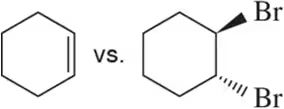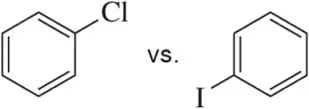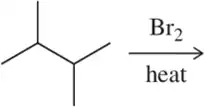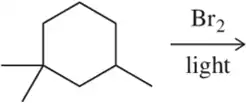 Back
Back Mullins 1st Edition
Mullins 1st Edition Ch. 11 - Properties and Synthesis of Alkyl Halides: Radical Reactions
Ch. 11 - Properties and Synthesis of Alkyl Halides: Radical ReactionsProblem 39b
In each pair, choose the most acidic compound. Justify your answer. The most acidic proton in each compound has been indicated.
(b)
Problem 40d
In each pair, choose the most basic compound. Justify your answer.
(d)
Problem 41a
Which of the reactions studied in this chapter result in oxidation of the organic molecule? Justify your answer.
(a)
Problem 41b
Which of the reactions studied in this chapter result in oxidation of the organic molecule? Justify your answer.
(b)
Problem 41c
Which of the reactions studied in this chapter result in oxidation of the organic molecule? Justify your answer.
(c)
Problem 41d
Which of the reactions studied in this chapter result in oxidation of the organic molecule? Justify your answer.
(d)
Problem 42(a)
In each pair,
(i) choose the compound that is most soluble in water.
(ii) Within each pair, which is most soluble in nonpolar solvents?
(a)
Problem 42a
In each pair, (i) choose the compound that is most soluble in water. (ii) Within each pair, which is most soluble in nonpolar solvents?
(a)
Problem 42b
In each pair,
(i) choose the compound that is most soluble in water.
(ii) Within each pair, which is most soluble in nonpolar solvents?
(b)
Problem 43a
In each pair, choose the compound you would expect to have the highest boiling/melting point.
(a)
Problem 43b
In each pair, choose the compound you would expect to have the highest boiling/melting point.
(b)
Problem 43c
In each pair, choose the compound you would expect to have the highest boiling/melting point.
(c)
Problem 44
Contrary to expectation, the addition of more fluorines to ethane lowers the boiling point. Explain this phenomenon.
Problem 45b
Predict the major product of the following bromination reactions.
(b)
Problem 45c
Predict the major product of the following bromination reactions.
(c)
Problem 46a
Predict the product of the following alkene addition reactions.
(a)
Problem 46b
Predict the product of the following alkene addition reactions.
(b)
Problem 46c
Predict the product of the following alkene addition reactions.
(c)
Problem 47a
Predict the major product(s) of the following allylic bromination reactions.
(a)
Problem 47b
Predict the major product(s) of the following allylic bromination reactions.
(b)
Problem 47c
Predict the major product(s) of the following allylic bromination reactions.
(c)
Problem 47d
Predict the major product(s) of the following allylic bromination reactions.
(d)
Problem 48a
Suggest a mechanism for the following reactions.
(a)
Problem 48b
Suggest a mechanism for the following reactions.
(b)
Problem 48c
Suggest a mechanism for the following reactions.
(c)
Problem 49
The following haloalkanes can all be prepared starting from the same alkene. Give the alkene and the reagents needed for each.
Problem 50
Identify the two different alkenes that undergo allylic halogenation to prepare the compound shown.
Problem 51a
For the following reaction, answer questions (a)–(d).
(a) Give an arrow-pushing mechanism, including the initiation step and two propagation steps.
Problem 51b
For the following reaction, answer questions (a)–(d).
(b) Which is the weakest bond in molecule A?
Problem 51d
For the following reaction, answer questions (a)–(d).
(d) Given your choice in (b), why is it the weakest bond?



























